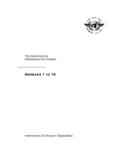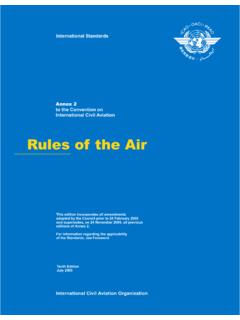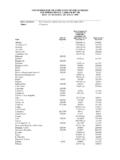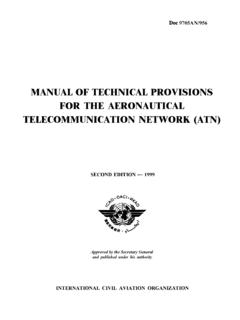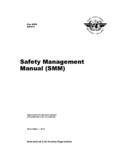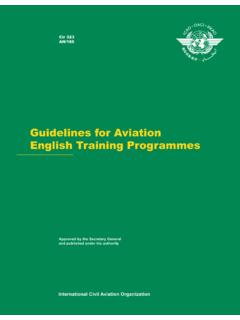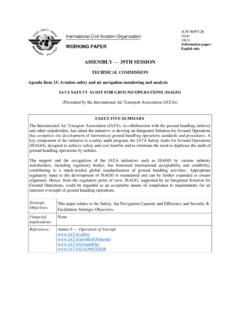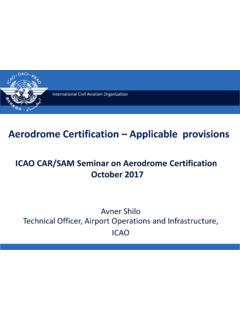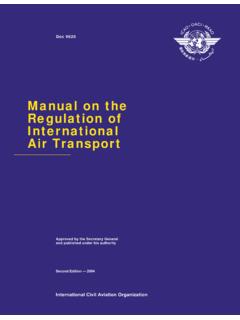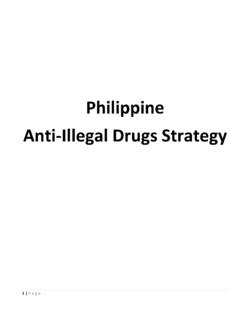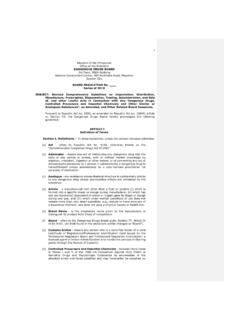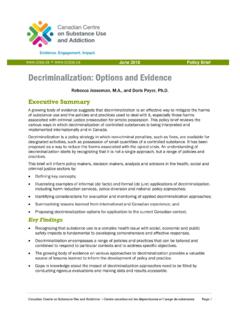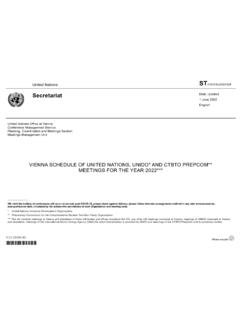Transcription of Annex 6 Operation of Aircraft Annex 6 Part 1, Chapter 6
1 Annex 6 Operation of Aircraft Annex 6 Part 1, Chapter 6 An aeroplane shall be equipped with: a) accessible and adequate medical supplies; Recommendation. Medical supplies should comprise: 1) one or more first-aid kits for the use of cabin crew in managing incidents of ill health; and 2) for aeroplanes required to carry cabin crew as part of the operating crew, one universal precaution kit (two for aeroplanes authorized to carry more than 250 passengers) for the use of cabin crew members in managing incidents of ill health associated with a case of suspected communicable disease, or in the case of illness involving contact with body fluids; and 3) for aeroplanes authorized to carry more than 100 passengers, on a sector length of more than two hours, a medical kit, for the use of medical doctors or other qualified persons in treating in-flight medical emergencies.
2 Note Guidance on the types, number, location and contents of the medical supplies is given in Attachment A. b) portable fire extinguishers of a type which, when discharged, will not cause dangerous contamination of the air within the aeroplane. At least one shall be located in: 1) the pilot s compartment; and 2) each passenger compartment that is separate from the pilot s compartment and that is not readily accessible to the flight crew; Note 1 Any portable fire extinguisher so fitted in accordance with the certificate of airworthiness of the aeroplane may count as one prescribed. Note 2 Refer to for fire extinguishing agents. c) 1) a seat or berth for each person over an age to be determined by the State of the Operator; 2) a seat belt for each seat and restraining belts for each berth; and 3) a safety harness for each flight crew seat.
3 The safety harness for each pilot seat shall incorporate a device which will automatically restrain the occupant s torso in the event of rapid deceleration; Recommendation. The safety harness for each pilot seat should incorporate a device to prevent a suddenly incapacitated pilot from interfering with the flight controls. Note Safety harness includes shoulder straps and a seat belt which may be used independently. d) means of ensuring that the following information and instructions are conveyed to passengers: 1) when seat belts are to be fastened; 2) when and how oxygen equipment is to be used if the carriage of oxygen is required; 3) restrictions on smoking; 4) location and use of life jackets or equivalent individual flotation devices where their carriage is required; and 5) location and method of opening emergency exits e) spare electrical fuses of appropriate ratings for replacement of those accessible in flight.
4 Any agent used in a built-in fire extinguisher for each lavatory disposal receptacle for towels, paper or waste in an aeroplane for which the individual certificate of airworthiness is first issued on or after 31 December 2011 and any extinguishing agent used in a portable fire extinguisher in an aeroplane for which the individual certificate of airworthiness is first issued on or after 31 December 2018 shall: a) meet the applicable minimum performance requirements of the State of Registry; and b) not be of a type listed in the 1987 Montreal Protocol on Substances that Deplete the Ozone Layer as it appears in the Eighth Edition of the Handbook for the Montreal Protocol on Substances that Deplete the Ozone Layer, Annex A, Group II. Note Information concerning extinguishing agents is contained in the UNEP Halons Technical Options Committee Technical Note No.
5 1 New Technology Halon Alternatives and FAA Report No. DOT/FAA/AR-99-63, Options to the Use of Halons for Aircraft Fire Suppression Systems. ATTACHMENT A. MEDICAL SUPPLIES Supplementary to Chapter 6, a) TYPES, NUMBER, LOCATION AND CONTENTS OF MEDICAL SUPPLIES 1. TYPES 2. The different types of medical supplies should be provided as follows: first-aid kit(s) for carriage on all aeroplanes, universal precaution kit(s) for carriage on all aeroplanes that require a cabin crew member, and a medical kit for carriage where the aeroplane is authorized to carry more than 100 passengers on a sector length of more than two hours. Where national regulations allow it, operators may elect to carry the recommended medication in the first-aid kit. Based on the limited available evidence, only a very small number of passengers are likely to benefit from the carriage of automated external defibrillators (AED) on aeroplanes.
6 However, many operators carry them because they offer the only effective treatment for cardiac fibrillation. The likelihood of use, and therefore of potential benefit to a passenger, is greatest in Aircraft carrying a large number of passengers, over long duration sector lengths. The carriage of AEDs should be determined by operators on the basis of a risk assessment taking into account the particular needs of the Operation . 2. NUMBER OF FIRST-AID AND UNIVERSAL PRECAUTION KITS First-aid kits The number of first-aid kits should be appropriate to the number of passengers which the aeroplane is authorized to carry: Passenger First-aid kits 0 100 1 101 200 2 201 300 3 301 400 4 401 500 5 More than 500 6 Universal precaution kits For routine operations, one or two universal precaution kits should be carried on Aircraft that are required to operate with at least one cabin crew member.
7 Additional kit(s) should be made available at times of increased public health risk, such as during an outbreak of a serious communicable disease having pandemic potential. Such kits may be used to clean up any potentially infectious body contents such as blood, urine, vomit and faeces and to protect the cabin crew members who are assisting potentially infectious cases of suspected communicable disease. 3. LOCATION First-aid and universal precaution kits should be distributed as evenly as practicable throughout the passenger cabins. They should be readily accessible to cabin crew members. The medical kit, when carried, should be stored in an appropriate secure location. 4. CONTENTS The following provides guidance on typical contents of first-aid, universal precaution and medical kits.
8 First-aid kit: List of contents Antiseptic swabs (10/pack) Bandage: adhesive strips Bandage: gauze cm m Bandage: triangular; safety pins Dressing: burn 10 cm 10 cm Dressing: compress, sterile cm 12 cm Dressing: gauze, sterile cm cm Tape: adhesive cm (roll) Steri-strips (or equivalent adhesive strip) Hand cleanser or cleansing towelettes Pad with shield, or tape, for eye Scissors: 10 cm (if allowed by national regulations) Tape: Adhesive, surgical cm m Tweezers: splinter Disposable gloves (multiple pairs) Thermometers (non-mercury) Mouth-to-mouth resuscitation mask with one-way valve First-aid manual, current edition Incident record form The following suggested medications can be included in the first-aid kits where permitted by national regulations: Mild to moderate analgesic Antiemetic Nasal decongestant Antacid Antihistamine Universal precaution kit.
9 Dry powder that can convert small liquid spill into a sterile granulated gel Germicidal disinfectant for surface cleaning Skin wipes Face/eye mask (separate or combined) Gloves (disposable) Protective apron Large absorbent towel Pick-up scoop with scraper Bio-hazard disposal waste bag Instructions Medical kit: Equipment List of contents Stethoscope Sphygmomanometer (electronic preferred) Airways, oropharyngeal (three sizes) Syringes (appropriate range of sizes ) Needles (appropriate range of sizes) Intravenous catheters (appropriate range of sizes) Antiseptic wipes Gloves (disposable) Needle disposal box Urinary catheter System for delivering intravenous fluids Venous tourniquet Sponge gauze Tape adhesive Surgical mask Emergency tracheal catheter (or large gauge intravenous cannula) Umbilical cord clamp Thermometers (non-mercury) Basic life support cards Bag-valve mask Flashlight and batteries Medication Epinephrine 1:1 000 Antihistamine injectable Dextrose 50% (or equivalent) injectable.
10 50 ml Nitroglycerin tablets, or spray Major analgesic Sedative anticonvulsant injectable Antiemetic injectable Bronchial dilator inhaler Atropine injectable Adrenocortical steroid injectable Diuretic injectable Medication for postpartum bleeding Sodium chloride (minimum 250 ml) Acetyl salicylic acid (aspirin) for oral use Oral beta blocker If a cardiac monitor is available (with or without an AED) add to the above list: Epinephrine 1:10 000 (can be a dilution of epinephrine 1:1 000) Note. The United Nations Conference for Adoption of a Single convention on narcotic drugs in March 1961 adopted such a convention , Article 32 of which contains special provisions concerning the carriage of drugs in medical kits of Aircraft engaged in international flight. _____
